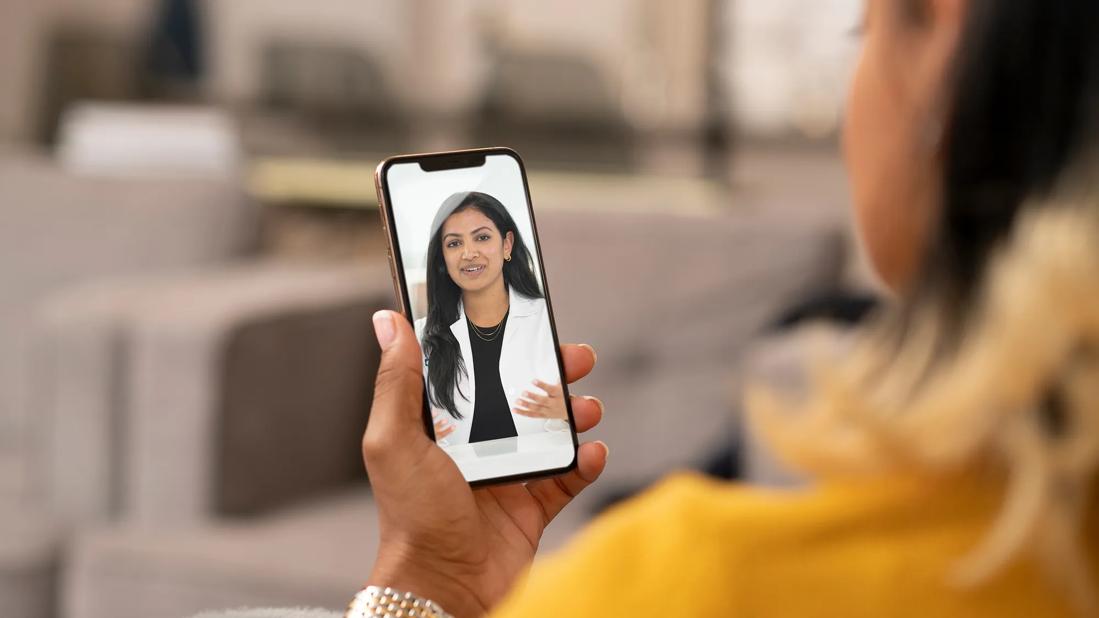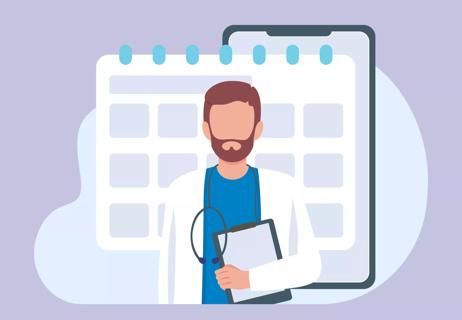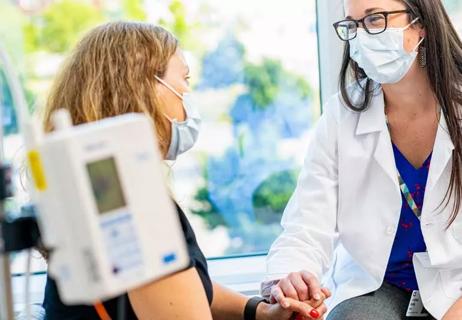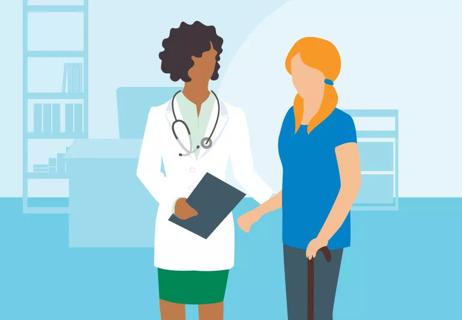Virtual doctor appointments offer a quick, accessible solution thanks to advances in telehealth

In this day and age, we can access almost anything at the tap of a finger.
Advertisement
Cleveland Clinic is a non-profit academic medical center. Advertising on our site helps support our mission. We do not endorse non-Cleveland Clinic products or services. Policy
Your healthcare is no exception.
From virtual visits to telemedicine consultations, medication refills, questions about test results and scheduling follow-up appointments with your primary care provider, accessing healthcare virtually and online has become easier in recent years thanks to advances in the telehealth space.
But just what can you expect from a virtual appointment, and will you receive the same level of care that you would if you were to come into the doctor’s office in person? And what’s the difference between telehealth and telemedicine anyway — and does the terminology matter?
Family medicine doctor Mark Rood, MD, breaks down the answers to these questions and more. Plus, family medicine doctor Neha Vyas, MD, shares how to make the most out of your next virtual appointment and what you can do when you’re preparing to have a virtual visit.
“Telehealth” is an umbrella term that describes the use of digital technologies (like the internet, smartwatches and computers) to distribute long-distance clinical healthcare services, public health and patient or professional health-related education.
Telemedicine is a specific area of telehealth that uses these digital technologies to directly connect patients with their healthcare providers in a virtual setting and provide them with information that directly informs or relates to their health and wellness journeys.
Advertisement
The three most common areas of telemedicine involve:
“Virtual visits are often the most cost-effective way to receive care,” says Dr. Rood. “We can treat lots of nonemergency problems virtually.”
Most insurance companies cover at least some form of virtual healthcare or telemedicine services, and may require a copayment for each visit. You can also schedule a virtual appointment with any healthcare provider at any institution who performs virtual visits, as long as they have a medical license for the state in which you’re in at the time of your appointment.
Caregivers can provide consultation to people who have a number of express care concerns and injuries. It tends to be quick and efficient and comes with the same level of care you would receive if you came into the doctor’s office — but without all the hassle of travel, finding parking or putting yourself at risk for further illness. This last part is often a big benefit for people who are immunocompromised and who are concerned about being exposed to other illnesses while traveling outside of their homes.
Because of the efficiency of telemedicine, virtual visits can be scheduled for issues like:
Advertisement
Healthcare providers are also able to provide consultations for any common primary care chronic conditions or mental health conditions, including:
“People are thrilled they have this ability to access healthcare,” shares Dr. Rood. “We can use virtual appointments as a conduit to get people into a brick-and-mortar center for primary care and specialty care, or we can develop a purely virtual relationship to allow for faster access to care than perhaps they might have if they were to try and get an appointment in the office.”
One limitation of virtual visits is that telemedicine should never be used in emergency situations. If you’re experiencing chest pain or shortness of breath, or believe you may be having a heart attack or stroke, you should call emergency services or seek in-person medical care right away.
“In-person care is especially important for conditions that require immediate intervention such as asthma or other respiratory conditions and infections which require medications in the form of injections,” stresses Dr. Vyas. “Symptoms such as chest pain and shortness of breath or acute abdominal or flank pain are best evaluated in person where time is of the essence.”
Advertisement
Another limitation is that telemedicine can sometimes be difficult to navigate if you’re unfamiliar with the technology or don’t have access to the internet and a computer, tablet or smartphone. In some cases, healthcare providers might allow the option of using the telephone without video for your appointments, but most virtual appointments use video in some way.
The reason for this is that your healthcare provider may want to do a visual exam and look you over for rashes or other physical symptoms related to your condition. Sometimes, your provider may recommend that you make a follow-up appointment for an in-person test or exam, like getting your blood drawn, getting a sleep study or having a strep test, but this happens only when it’s most necessary.
For the best experience, you should plan to enable a video component. If you’re unfamiliar with video or telehealth equipment, be sure to have someone nearby who can help you with technical problems in real-time.
Before your virtual appointment, you’ll want to download a free app like the MyClevelandClinic® app. These platforms are designed to be user-friendly. “It’s very straightforward,” reassures Dr. Rood. “And if you need help, most physicians’ offices will talk you through the setup over the phone.”
Advertisement
Depending on where you’re receiving care, each individual institution may have its own app with varying features. But the general idea is to improve your user experience and minimize the sometimes-complicated process of getting medical attention and treatment.
“We’re not constrained by needing a physical space, we’re not constrained by the time it takes for a medical assistant to check you in, and there’s no travel time and no traditional waiting room with virtual visits,” notes Dr. Rood.
Whether you schedule your virtual visit with your healthcare provider or through an app, you’ll want to check a few things to make sure everything is in order so that your appointment runs smoothly:
Before every appointment, there’s usually a precheck-in questionnaire that asks a series of questions about your medical history, current symptoms, your level of pain and the kinds of medications you’re taking. This is all important information your care provider needs in order to make an informed decision about your diagnosis and treatment plan.
Filling out this paperwork or questionnaire before the start of your virtual visit helps get it out of the way so that you’re not wasting time during the visit covering all of this basic information. Make sure you also understand the payment and reimbursement process, and that your medical insurance information is up-to-date before the start of your appointment.
Before your appointment, make sure you have everything set up. Test your webcam and microphone to make sure they’re working. Check to see that you have the correct login information and video conference or streaming service downloaded for the telemedicine appointment. You also want to make sure the light source in the room is to the side or above you, not behind you. Like when you take a photo, it’s difficult to see people when they’re sitting in front of a window with the shades open. Also, make sure that your camera screen is free from dirt for the best possible visual inspection.
Sign on for your virtual visit 10 to 15 minutes early and remain logged on until the provider arrives. Try not to exit the virtual visit or refresh the page or app, as this could interrupt the service or cause issues logging in. If you have issues connecting or logging into your appointment, you can often call your provider’s office and get assistance. It’s better to do this as early as possible to avoid confusion or potential cancellations.
Make sure your provider can see your face and your upper chest. Unless you’re really feeling poorly, try to stay upright and seated during your visit, and don’t move from one room to another. This will allow your provider to evaluate you similarly as they do in the office. When you’re speaking, your care provider will examine the way your chest moves and if your facial muscles are moving synchronously.
Keep track of important information, tips and after-visit care guidelines (and in most cases, providers might even send you a list of after-visit care tips with a more detailed summary of your visit).
It’s also helpful to have a penlight or a flashlight on hand so that you can spotlight areas on your body where you may have a rash or injury. Or you can take a picture of the affected area and ask the medical assistant how to send it to your provider.
If possible, have someone else care for young children or animals in another room so you and your provider can focus on your visit. You don’t want to have your virtual visit, say, in a coffee shop, in a kitchen while someone is cooking or outside where there’s a running lawn mower. Noise can not only disrupt the call, but also make it more difficult for the provider to diagnose your situation.
Guests or family members should also wait in another room until your appointment is over unless they’re in the room to assist or provide additional information for your virtual visit. As sensitive information will be discussed during your visit, this can help protect your privacy and get the same level of one-on-one care you would get if you were to come into an office.
This may happen on your end or your provider’s end, particularly if there’s a poor internet connection. This can cause the flow of your conversation to be a little bit slower. Use shorter sentences and allow more pauses in the conversation so your medical provider doesn’t miss anything you say.
Healthcare providers who offer virtual visits are able to give the same level of quality care using telemedicine that you would receive if you were to come into an office in person.
“By design, virtual appointments help people get the care they need in the timeliest way possible,” emphasizes Dr. Rood.
During a virtual appointment, your healthcare provider will likely ask you a series of questions about what brings you to the appointment, about any symptoms you’re experiencing or any underlying medical conditions you have that may be affecting those symptoms. They may also ask you about medications you’re on and other questions about your medical history. If there are physical characteristics associated with your visit — like a rash, blemish or bruise — your healthcare provider may also ask to see that on camera to assess the situation and provide a diagnosis.
From there, if any prescription medications are needed, your healthcare provider will send those prescriptions to a pharmacy of your choice. They can also work with you to schedule a follow-up virtual visit should you need it. In some situations, healthcare providers may need to schedule an in-person follow-up when things like blood draws or further evaluation would be more beneficial in person.
Between appointments, if you have any follow-up questions about what you’ve discussed, experience any adverse effects from the medications you’ve been prescribed or need any medication refills, you can use telemedicine services to contact your healthcare provider and communicate these needs openly and directly with them. Note that some medications may require an in-person visit before you’re able to get a prescription if they’re considered a controlled substance, like certain ADHD medications or opioids.
We’ve seen an abundance of innovation in healthcare over the years that continues to progress every single day. With the addition of telemedicine services and the accessibility provided by virtual visits, healthcare is more seamless and efficient now more than ever — and that’s the goal. By providing everyone access to healthcare — no matter who they are, what they’re facing or where they live — telemedicine is designed to tear down barriers and provide help to those in need whenever they need it most.
If you’re interested in scheduling a virtual appointment with a healthcare provider or specialist, contact your provider’s office today to get that appointment on your digital calendar. There’s no better time to take care of your health and wellness than today.
Learn more about our editorial process.
Advertisement

All states require DTaP, MMR, polio and chickenpox vaccines — healthcare providers recommend others, too

Here’s how (and why) to ask your doctor about treatment goals, second opinions, clinical trials and more

Over-the-counter pills, powders, extracts and tinctures can interact with other medications and cause unexpected side effects

A second opinion can confirm your diagnosis and treatment plan and help you feel more confident about what’s next

Signs are what your provider can see, but symptoms are what you feel or experience

Screenings and tests done during a wellness check can uncover hidden health issues

Typically, you can keep your appointment, let your gynecologist know and let your worries go

An annual physical exam is important for many reasons, including your chance to ask questions

The best parenting style balances enforcing rules and showing plenty of love

Tips include cutting back on sugar, focusing on exercise and managing stress

It can be harder to let go when you’ve invested time, energy and emotions — but it might be the healthier choice long term